The serratus muscle is located in the anterior part of the chest wall. Anatomically she acts on the scapula and is its main engine.
Serratus anterior is a superficial chest muscle located in the anterior chest wall.
Record content:
- 1 What is it, anatomy
- 2 Functions and properties
- 3 Anatomy and structure
-
4 The main set of exercises
- 4.1 Doing regular push-ups
- 4.2 Dumbbell Incline Press
- 4.3 Weight Exercise (Dumbbell Pullover)
- 4.4 Pull-ups on the horizontal bar with a narrow grip
- 4.5 Lying Leg Pulls
- 5 Week schedule
- 6 When to expect an effect
- 7 Serratus anterior video
What is it, anatomy
Musculus serratus anterio (serratus anterior muscles) - thin, flat, fan-shaped muscles located on the sides. Each starts from the chest, runs diagonally upward, attaches to the scapula, and in front - to the pectoralis major and minor.
Between the serratus anterior and adjacent muscles, there is a fat cell membrane that covers the entire serratus and helps it slide. The range of mobility of the scapula depends on the anterior muscle at the time of moving the arm up.
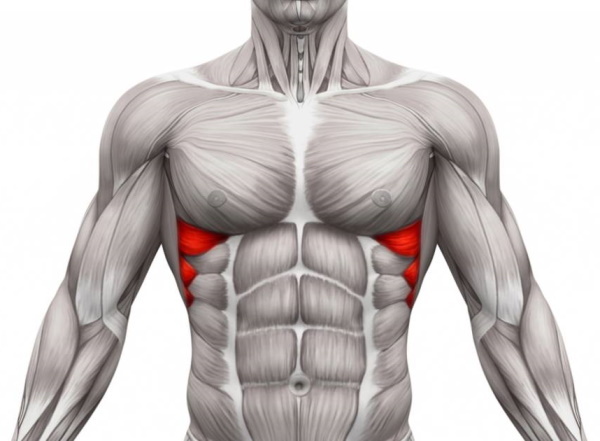
The serratus anterior muscle, whose anatomy differs from other chest muscles, is clearly visible on the athletic torso of a pumped-up athlete.
Functions and properties
Since the serrated muscle connects the scapula to the ribs, this makes it a multifunctional muscle. The scapula can be raised by the top of this muscle and can be lowered by the middle and bottom of the dentate muscle.
In addition, the lower part of the muscle allows the scapula to separate its base outward and rotate, which allows raise the arm above 90 ° (external tilt), an action that it performs in conjunction with the trapezius muscle.
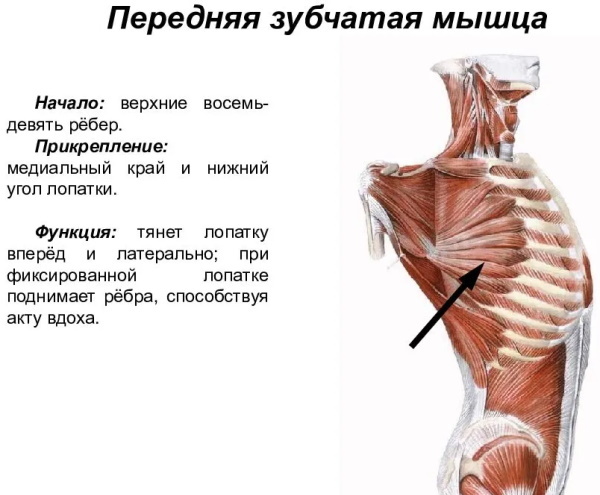
The muscle serves as a support to give stability to the scapula, especially when applying pressure on the shoulder, for example, using crutches for walking, doing elbow flexion (push-ups) exercises, practicing the bench press lying down.
In this case, the muscle resists so that the shoulder does not go beyond its normal limits. The muscle is involved in lifting the ribs during inhalation, so it is an accessory respiratory muscle.
As an antagonist, the dentate muscle offers some resistance to the prime mover, the rhomboid muscle. If the toothed blade pulls or pulls the blades away from each other, then the diamond-shaped one pulls them towards each other. Together they form a wide muscular loop that wraps around the torso and presses the shoulder blade against it.
Dysfunction includes myofascial pain syndrome, in which one or more functional muscle units are affected. Overloading the serratus can cause pain points known as trigger points.
These are muscle contractures that are concentrated in one or more specific locations and feel like hard areas. These points are painful on palpation, as well as when trying to move or stretch a muscle.
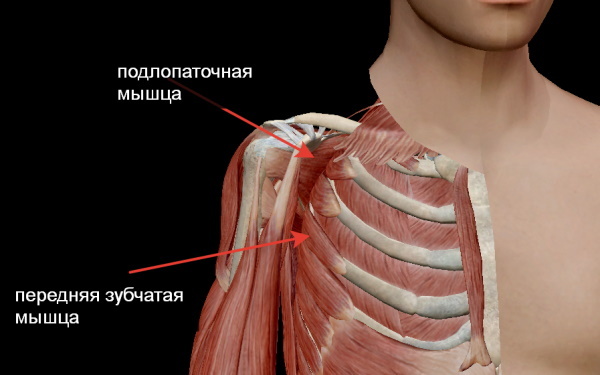
The pain spreads to the ribs, shoulder blade and inner surfaces of the hands, as well as to the ring finger and little finger. Contraction can make breathing difficult. Trigger points are removed with massage.
Dysfunction also includes the development of pterygoid scapula syndrome. This pathology is caused by trauma to the long thoracic nerve, which leads to muscle paralysis and atrophy.
Therefore, the syndrome is characterized by deformation (medial unevenness) of the scapula, which directly affects the mobility of the shoulder. Flexibility, strength, mobility are sharply reduced. The nerve can be damaged due to surgery, injury, or excessive weight bearing.
The serratus muscle is involved in the development of pain in the area:
- between the shoulder blades;
- in the elbows;
- ribs;
- hand.
Anatomy and structure
The serratus anterior muscle, the anatomy of which is peculiar, is a paired muscle. Each is stretched in the form of fingers (tufts) on the sides of the body. The muscle begins with large teeth on the upper eight or nine ribs and attaches to the medial edge and lower angle of the scapula.
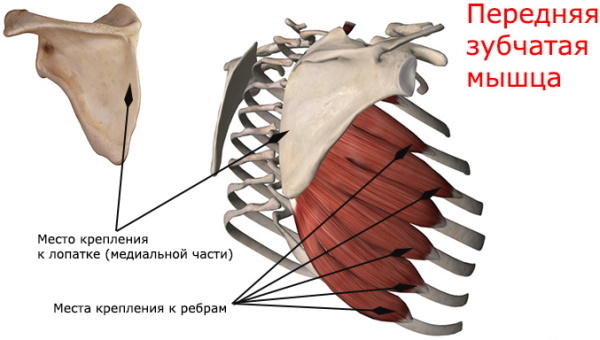
Structurally, it has 3 bundles. The upper and middle ones lie horizontally, the lower beams are located obliquely and go from front to back and from bottom to top. The teeth of the external oblique muscle of the abdomen enter the spaces between the lower teeth.
The muscle layer of the dentate muscle can be divided into 3 zones:
- Top part includes an area that covers the first and second edges (first origin). The muscle fibers of the I and II ribs moderately converge to the upper edge of the scapula.
- middle part represented by the area that covers the second and third edges (second origin). Outgoing bundles from II to IV ribs diverge to the medial edge of the scapula.
- Bottom part refers to the region corresponding to the fourth and ninth edges (third origin). The last ribs from V to IX converge strongly at the edge or lower corner of the scapula. It is the strongest and most prominent part of the muscle.
The long pectoral nerve (nervus thoracicus longus) originates from the anterior branches of the C5-C7 brachial plexus and is responsible for the innervation of the serratus anterior muscle, which is why some call it the large serratus nerve. However, other sources refer to it as Bell's external respiratory nerve.
Nerve damage causes weakness, paralysis, and muscle atrophy, resulting in a pathology known as the alata (winged) scapula. The nerve passes behind the mid-axillary line and continues below the pectoral muscles, then descends vertically to the 4th or 5th finger of the serratus anterior muscle, from where the branchings enter the muscle.
Anatomically, the blood supply to the serratus anterior muscle occurs due to the branch of the lateral thoracic artery and the branch of the scapular circumflex artery.
The main set of exercises
Warming up the muscles a few minutes before starting activity is important as it increases muscle temperature and helps to increase muscle flexibility. Stretching is recommended after warming up to improve muscle performance.
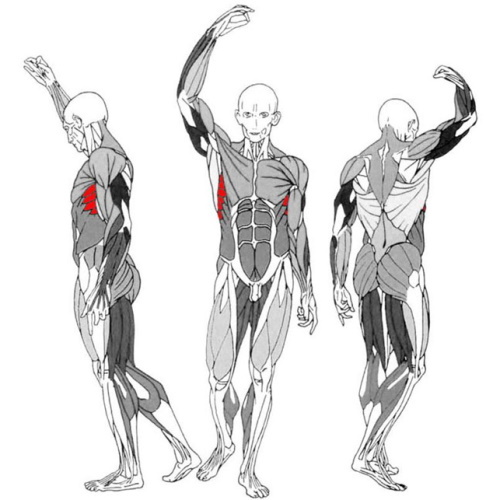
At the end of the session, before stopping completely, you should slow down the pace of the exercise and make sure that the muscles have cooled down. It helps prevent dizziness, fainting, or nausea, and also helps remove lactic acid from the muscles. During this time, the outflow of blood from the lower extremities to the brain also increases.
Experts recommend stretching such as push-ups and push-ups plus. These exercises with a closed kinetic chain do not require special gymnastic equipment, but are carried out using their own weight for resistance.
Support on a narrow palm width at the time of exercise, increases the activity of the muscles of the pectoralis major and minor, triceps brachii and infraspinatus muscle, while full palm support increases the activity of the dentate anterior muscles, which is important for stability shoulder blades.

The activity of the serrated muscles increases with push-ups as the angle of the legs increases (by raising the platform of the foot).
The following stretching exercises should be performed for 30 seconds. from each side:
- Stretch your arms, stand shoulder-width apart. Place your left hand on your thigh. Extend your right arm up diagonally and pull it back slightly until you feel a stretch in your chest. Change the position of the hands.
- Stand in front of a wall, feet shoulder-width apart. Stretch your arms up diagonally and rest your palms on the wall. Tilt your upper body forward until you feel a stretch in your chest.
- Stand in a position so that the left side of the body is in front of the wall and the left foot is in front. Bend your elbow at a right angle and press your palm and elbow against the wall. Place your right hand on your thigh. Rotate your upper body slightly to the right until you feel a stretch in your chest. Do the same on the other side.
- Stand in a doorway or against a wall. Straighten your spine. Place your right hand on a doorframe or wall at shoulder level. Bring the right shoulder blade closer to the spine. Keep the right palm firmly against the wall and rotate the body counterclockwise until the torso is facing forward and the right hand is at the back. Hold the stretch for 20 seconds, then repeat on the opposite side.
The group of training exercises includes classes with and without weights.
Doing regular push-ups
Exercise with a wide spread of arms sufficiently loads the pectoral muscles. In a prone position, face down, hands are placed on the floor at shoulder level, elbows are extended. Keep your back and legs straight with your toes touching the floor.

- The body is lowered until the shoulder is parallel to the ground.
- Then the shoulders are raised, the arms are extended.
In addition to a wide spread of arms, presses with a narrow spread of arms are carried out. They are used to develop strength and work out the internal muscles. In the initial position, in this case, the hands are placed in such a way that the fingers of one hand almost touch the other.
Dumbbell Incline Press
- Lie with your back on an incline bench.
- Make sure that your feet remain on the ground throughout the entire exercise.
- Hold a dumbbell in a neutral grip in each hand.
- First, the arms are pressed to the body, the top of the dumbbell touches the shoulder joint. Extend your arms up until the dumbbells are perpendicular to your shoulders.
- Bend your elbows and place the dumbbells at chest level. Hold in this position and take your hands back in a controlled manner.
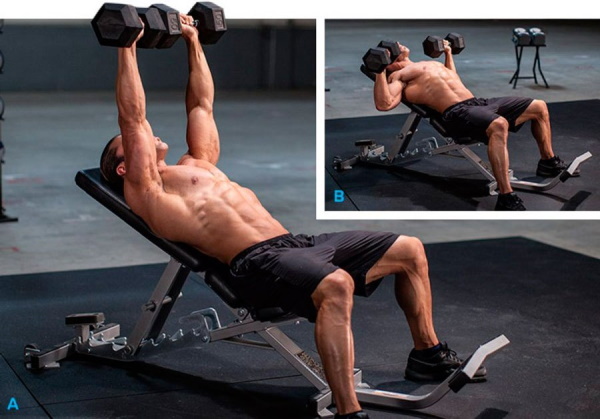
The exercise is done in 4 sets of 6 reps.
Weight Exercise (Dumbbell Pullover)
- Lie with your back on the bench, take a dumbbell by one end with both hands.
- Stretch your arms up, bending your elbows, holding a dumbbell.
- Smoothly lower the dumbbell down, behind your head, without bending your arms, while feeling the stretching of the chest.
- Hold this position for a few seconds.
- Return to starting position by exhaling air.
- Inhale - lower your arms, exhale - return to the starting position.

Do 3-6 sets of 15-20 reps each.
Pull-ups on the horizontal bar with a narrow grip
The exercise is performed 10-12 times.
- Hanging is done on the horizontal bar, then the leg slowly rises until it touches the chest with the knee.
- Holding the leg in this position for 3 seconds, slowly return it to its original position.
- Repeat the exercise with the other leg.
The optimal number of repetitions for each leg is 4-5 times.
Lying Leg Pulls
This exercise repeats the above, but is performed while lying on a sports bench. Alternately raising your legs, bending your knees, you should reach your chest or shoulder. To enhance the effect, you can change the angle of the bench with each set.
Week schedule
When training and stretching the jagged muscles, it should be remembered that they belong to muscle structures that are physiologically designed for long-term work. When training, it should be borne in mind that the muscles of the chest do not like a small number of approaches and a large weight, therefore, quantity is much more important than quality.
When making a training plan, you should provide for more repetitions, but at the same time not increase the weight. Any exercise that involves stretching or pumping the pectoral muscles should not be done daily. From frequent training, these muscle groups receive microtrauma.
The serratus anterior muscle (the anatomy of this structure is presented on the site) increases the range of motion and mobility of the arm when it is directed forward and upward. The development of these movements improves the person's ability to hit.

Such muscle groups should be pumped no more than 2 times a week. It is better to end the workout with a pull over exercise. To pump up normally, it is enough to do simple push-ups from the floor.
First workout of the week:
| Exercises | Approaches | Reruns |
| Regular push-ups | 5 to 12 times | 15-20 |
| Hang on the turnstile | 4 to 12 times | — |
| Push-ups with full arm | 4 to 12 times | — |
| Push-ups with a narrow stance | 6 to 12 times | — |
| Dumbbell Pullover | 4 to 12 times | — |
The total number of approaches should be from 4 to 12. For beginners, it is enough to do 2-3 approaches.
Activities to do during the second workout of the week:
| Exercises | Approaches | Reruns |
| Push-ups on the bar | 5 to 15 times | 20 |
| Push-ups on full arms | 4 to 20 times | 25 |
| Lying Pull-Up | 4 to 12 times | 15 |
| Dumbbell Pullover or Dumbbell Bench Press | 4 to 12 times | — |
A pause of 40-50 seconds is made between approaches. In between exercises, you can do several stretching movements. The logic for creating an exercise program is based on dividing muscles into segments. An exercise should be selected for a group of pulling and pushing movements.
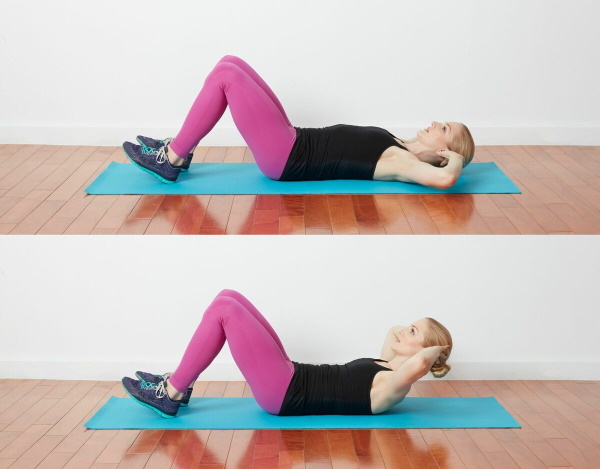
- Monday: swinging the press (shoulders, chest, triceps).
- Tuesday: swinging traction muscles (biceps, back).
- Wednesday: rest.
- Thursday: legs (thigh muscles, calves, abdominal muscles).
- Friday: rest.
- Saturday: swinging the press (shoulders, chest, triceps).
- Sunday: traction muscles (back, biceps).
In order for the training to bring tangible results, you should adhere to some rules:
- Comprehensive exercise is the key to success. Don't focus too much on one muscle group. A strong chest requires a strong back at the same time. Poor posture can be avoided in this way.
- Gradually reduce the rest time between sets, for example, from 1 minute to 30 seconds.
- Use combined approaches. For example, you can do one set on the upper and lower chest at a time.
- Apply the principle of "rest-pause" (after the planned exercise, rest for 5-10 seconds, and then do a few more final repetitions).
These recommendations will help you achieve the desired results faster. If the training was too intense and at the same time all conditions were not created for a quick and complete recovery, there is a high probability of developing overtraining and stagnation.
When to expect an effect
The serratus anterior, whose anatomy affects the other pectoral muscles, is a small powerhouse in the chest. With proper attention, proper training, it can create stability in the shoulder girdle, develop deep breathing and form an extension for the development of a beautiful 6-pack abs.
In order to build the muscles of the upper chest, an integrated approach to the development of all muscles in this area is required. To do this, you should alternate exercises. Exercising large muscle groups 2 times a week is the easiest way to induce muscle growth.
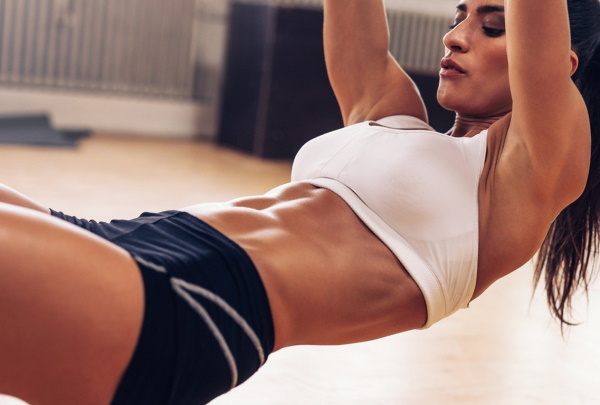
Each organism requires an individual training program, so you should not blindly follow someone else's program without knowing the specifics of your body. Workouts can be devoted both to individual days, or to include them in the program for the total load of the shoulders, back and arms.
The speed of muscle building depends on the stability of the training, the number of loads, reps and approaches. But you should always remember that a rapid increase in loads leads to microtraumas. Over the course of a few months, exercise can help strengthen your internal pectoral muscles.
For best results, stretching is best done immediately after workouts that involve heavy use of the serratus anterior muscle. It is advisable to increase the intensity of the stretch with each repetition.
The serratus anterior muscle is the main stabilizer of the scapula. Trauma to this area can cause pain, limited movement, swinging of the scapula, and difficulty using the arm. Understanding the anatomy and function of the muscle structure will help to properly repair it after injury.
Serratus anterior video
Anatomy of the serratus anterior muscle:



